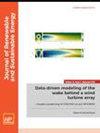Capacity configuration optimization of energy storage for microgrids considering source–load prediction uncertainty and demand response
IF 1.9
4区 工程技术
Q4 ENERGY & FUELS
引用次数: 0
Abstract
The fluctuation of renewable energy resources and the uncertainty of demand-side loads affect the accuracy of the configuration of energy storage (ES) in microgrids. High peak-to-valley differences on the load side also affect the stable operation of the microgrid. To improve the accuracy of capacity configuration of ES and the stability of microgrids, this study proposes a capacity configuration optimization model of ES for the microgrid, considering source–load prediction uncertainty and demand response (DR). First, a microgrid, including electric vehicles, is constructed. Second, the uncertainty of renewable energy resources and electric demand is handled by Monte Carlo scenario generation techniques and K-means-based scenario reduction techniques. Then, a DR model combining price-based demand response and incentive-based demand response is constructed to achieve a better match between electricity demand and supply. Finally, the results of the ES capacity configuration are determined with the objective of minimizing the total daily cost of the microgrid. The simulation results show that the optimal configuration of ES capacity and DR promotes renewable energy consumption and achieves peak shaving and valley filling, which reduces the total daily cost of the microgrid by 22%. Meanwhile, the DR model proposed in this paper has the best optimization results compared with a single type of the DR model. It is verified through comparative analysis that under a certain proportion of flexible loads, the total daily cost of the microgrid is the lowest when the time-shiftable loads and the curtailable loads are both 10%.考虑源负载预测不确定性和需求响应的微电网储能容量配置优化
可再生能源资源的波动和需求方负荷的不确定性会影响微电网中储能(ES)配置的准确性。负荷侧的峰谷差过大也会影响微电网的稳定运行。为了提高储能系统容量配置的准确性和微电网的稳定性,本研究提出了一种微电网储能系统容量配置优化模型,并考虑了源负荷预测的不确定性和需求响应(DR)。首先,构建一个包括电动汽车在内的微电网。其次,通过蒙特卡罗情景生成技术和基于 K-means 的情景还原技术处理可再生能源和电力需求的不确定性。然后,构建了基于价格的需求响应和基于激励的需求响应相结合的 DR 模型,以实现电力需求与供应之间的更好匹配。最后,以微电网每日总成本最小化为目标,确定了 ES 容量配置的结果。仿真结果表明,ES 容量和 DR 的最优配置促进了可再生能源的消纳,实现了削峰填谷,使微电网的日总成本降低了 22%。同时,与单一类型的 DR 模型相比,本文提出的 DR 模型优化效果最佳。通过对比分析验证,在一定的灵活负荷比例下,当可时移负荷和可削减负荷均为 10%时,微电网的日总成本最低。
本文章由计算机程序翻译,如有差异,请以英文原文为准。
求助全文
约1分钟内获得全文
求助全文
来源期刊

Journal of Renewable and Sustainable Energy
ENERGY & FUELS-ENERGY & FUELS
CiteScore
4.30
自引率
12.00%
发文量
122
审稿时长
4.2 months
期刊介绍:
The Journal of Renewable and Sustainable Energy (JRSE) is an interdisciplinary, peer-reviewed journal covering all areas of renewable and sustainable energy relevant to the physical science and engineering communities. The interdisciplinary approach of the publication ensures that the editors draw from researchers worldwide in a diverse range of fields.
Topics covered include:
Renewable energy economics and policy
Renewable energy resource assessment
Solar energy: photovoltaics, solar thermal energy, solar energy for fuels
Wind energy: wind farms, rotors and blades, on- and offshore wind conditions, aerodynamics, fluid dynamics
Bioenergy: biofuels, biomass conversion, artificial photosynthesis
Distributed energy generation: rooftop PV, distributed fuel cells, distributed wind, micro-hydrogen power generation
Power distribution & systems modeling: power electronics and controls, smart grid
Energy efficient buildings: smart windows, PV, wind, power management
Energy conversion: flexoelectric, piezoelectric, thermoelectric, other technologies
Energy storage: batteries, supercapacitors, hydrogen storage, other fuels
Fuel cells: proton exchange membrane cells, solid oxide cells, hybrid fuel cells, other
Marine and hydroelectric energy: dams, tides, waves, other
Transportation: alternative vehicle technologies, plug-in technologies, other
Geothermal energy
 求助内容:
求助内容: 应助结果提醒方式:
应助结果提醒方式:


